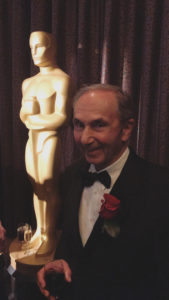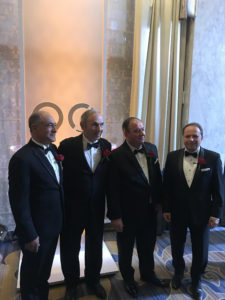
For the second straight year, the Academy’s SciTech awards reached into the Star Trek universe to find a host: Last year, John Cho, the current Sulu voyaging on the Enterprise, anchored the evening along with Leslie Mann. This year, there was only one, but what a one: Sir Patrick Stewart, who brought both gravitas and humor to the night.
Besides his turn as Capt. Picard, Stewart has had, of course, a number of years and films in the Professor X role, in the X-Men universe. But lest we forget, he’s also spent similar decades as a member of the Royal Shakespeare Company.
Thus, when he ended the evening with a monologue written by a writer “some 400 years ago,” and launched into Puck’s monologue from Midsummer Night’s Dream about the power of illusions: “If we shadows have offended/Think but this, and all is mended /That you have but slumber’d here /While these visions did appear” -we were reminded that “vision-making” has been with us for centuries.
For the Elizabethans, there were spurting limbs and sailing ships in shadows, among their numerous mechanical stage tricks. For The Academy, in terms of the tech and software honored, once again, at the Beverly Wilshire hotel ballroom -there were both mechanics and digits in the mix.
Indeed, Stewart sounded those same themes at the evening’s outset, telling the assembled they “turn equations and codes into visions.”
Not that there still aren’t some mechanics that would be familiar to the Elizabethans: North Hollywood-based Leonard Chapman was honored for the company’s “Hydrascope,” which allows a shot “as old as movies themselves,” as Stewart put it -the crane shot -to be done in and out of, and through, fresh or salt water.
Some stalwarts of the digital age were also re-honored -both Nuke compositing systems, and the Houdini visual effects packages – for what was called the “stewardship” of these legacy, and foundational VFX systems, by the Academy.
 Among the Nuke honorees was Abigail Brady, who was the first transgender honoree in SciTech’s history, but oddly, as a result, now finds herself among a too-small handful of women who receive such honors. ILM’s Rachel Marie Rose was one for her role in creating ILM’s BlockParty rigging system, who noted her award was “proof you can,” to any other young women wondering about scaling the gender battlements of a tech career.
Among the Nuke honorees was Abigail Brady, who was the first transgender honoree in SciTech’s history, but oddly, as a result, now finds herself among a too-small handful of women who receive such honors. ILM’s Rachel Marie Rose was one for her role in creating ILM’s BlockParty rigging system, who noted her award was “proof you can,” to any other young women wondering about scaling the gender battlements of a tech career.
And the rarely handed-out Gordon E. Sawyer award, for contributions that have made “an extraordinary and lasting impact” on movie making, was bestowed to Star Wars, Star Trek (and Spaceballs) VFX alum Jonathan Erland, not as much for his specific contributions to those films, but the series of inventions and patents he’s acquired since, helping advance the art, and tech, of visual effects.
He called for letting cinema be “an agent of change in our society,” contrasting its potential, as both an artform, and an institution, with many of its “best practitioners” already ensconced in the Academy, with past transgressions like participation in the Hollywood blacklist of the mid-20th century.
One early gauge of potential change will be to see how many of the evening’s more pointed remarks, whether from Erland, Rose, or anyone else, make it to Oscar broadcast night if he Academy decides to include them in the SciTech highlight reel, or whether the evening will be “slumber’d” through by most of the viewers.
Which would be a shame, since it was a fairly lively night. And even, dare we say, a wee bit “woke.”





